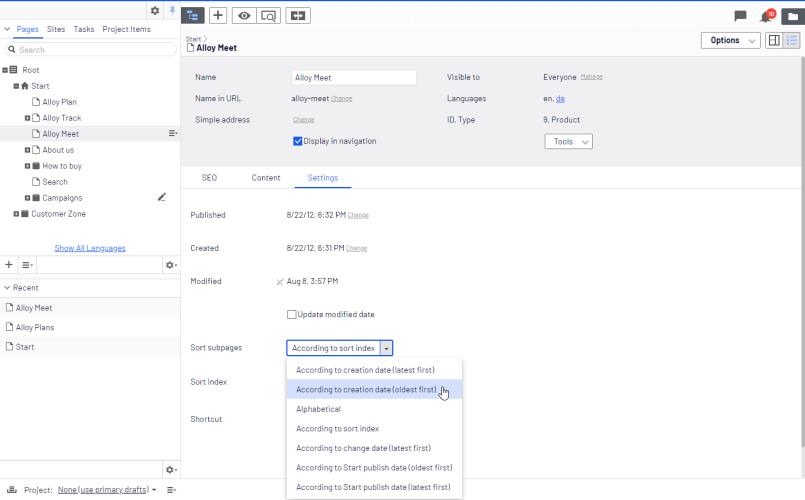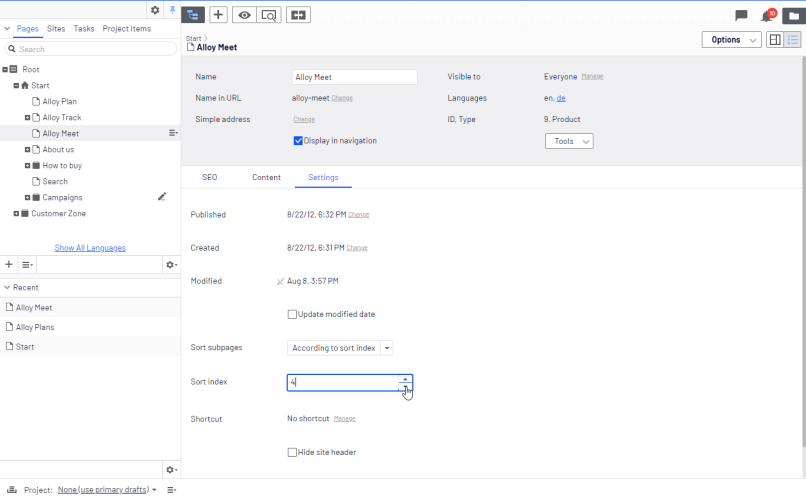 Structuring the website
Structuring the website
In the Optimizely CMS, the page tree structure is located in edit view under Pages. At the top of the structure is the root page, usually with one or more start pages directly underneath. The structure of the website is made up of pages. By default, the page structure is reflected in the navigation menus. To simplify navigation, limit the submenu structure to a maximum of three levels.
Page tree
By hovering over a page in the tree structure, information about the page appears, such as ID and page type. A set of page tree symbols provides additional information about the structure. Note that some of these icons are only displayed for the first draft version of a page, before any published version exists.
|
|
The root page. |
|
|
Start page. |
|
|
Published page. See Working with versions. |

|
Page that links to another page on the same website. See Shortcut to page in Optimizely CMS under Shortcut in Working in All properties editing view. |

|
Page that links to an external website or a specific address. See Shortcut to page on another website under Shortcut in Working in All properties editing view. |

|
Page containing a shortcut that is not linked anywhere; it only displays the text and is used to create a heading with no link in the menu. See No shortcut, display text only under Shortcut in Working in All properties editing view. |

|
Page that fetches and displays content from another page on the same website. See Fetch content from page in Optimizely CMS under Shortcut in Working in All properties editing view. |
|
|
Container page used for storing other pages; not visible on the website. |
|
|
Draft of a new page; not visible on the website yet. See Working with versions. |
|
|
New page scheduled for publishing; not visible on the website yet. See Working with versions. |
|
|
Expired page; not visible on the website anymore. See Working with versions. |
|
|
Page that is set to Ready to Publish. See Working with versions. |
|
|
Page that is set to Rejected. See Working with versions. |
|
|
Page is currently In review and must be reviewed and approved before it can be published. See Content approvals. |
|
|
Previously published page; not visible on the website anymore. See Working with versions. |
|
|
Page locked for editing for the logged-in user. |
|
|
Page being edited by another user. You can see who by hovering your mouse over the icon. |
|
|
Published page. Note: This icon appears for project items; not in the Pages navigation pane. See The projects feature. |
|
|
You do not have the rights to publish this item or the specific item version does not exist anymore. Note: This icon appears for project items; not in the Pages navigation pane. See The projects feature. |
Your website might be customized with other symbols implemented by the partner developer.
Moving, copying and removing pages
Moving a page
Use drag and drop to move a page, or select Cut in the context menu for the page you want to move, and select Paste for the destination page. You can also move pages by using the keyboard commands CTRL+X for cut (on Mac: CMD+X), and CTRL+V for paste (on Mac: CMD+V).
When you move a page, internal links are redirected to the new location and are not broken. However, any external links pointing to the moved page will be broken.
Copying a page
Press CTRL (or on Mac: Option) on your keyboard and drag and drop to copy a page, or select Copy in the context menu for the page you want to copy, and then select Paste for the destination page. You can also copy pages by using the keyboard commands CTRL+C for copy (on Mac: CMD+C), and CTRL+V for paste (on Mac: CMD+V).
Subpages and associated media files in local page folders are copied also, and the links point to the new copy of the page. Settings, such as dynamic properties and categories, are copied also with the new page.
When you copy and paste a page under the same node, the Name in URL property of the copied page is typically named Name in URL1, which you need to change after copying.
Removing content
Removed folders, pages, blocks and media files are moved to trash, and are not publicly available on the website. Remember to update any links to removed content. When you remove a page, all underlying pages are removed also. See Deleting and restoring content.
Sorting page order in menus
The pages in the tree structure are sorted according to a predefined sort order. By default, the page that was created most recently is placed at the top of the tree structure, for example, in news listings. There also are other options for sorting, such as alphabetically or by sort index. The last option lets you control the sorting through an index defined on each page.
The sort order is set for the parent page of a branch, and is inherited by the subpages:
- Select the parent page of the branch in the structure where you want to set the sorting.
- Edit the page and select the Settings tab.
- Select sorting criteria under Sort subpages.
- Publish the page for the changes to take place.
Sorting according to sort index
If you want to control exactly how the pages in the structure are sorted, select the According to sort index option for the parent page. Then give each child page a unique sort index number, and they are sorted in ascending order according to their number, with the lowest number on top.
Change the sort order of pages by dragging the page and dropping it where you want it in the tree structure. Sorting pages with drag and drop is only of interest for branches that are sorted with sort index.
- If you move a page into a branch that is not sorted according to sort index, you get prompted to move the page and at the same time apply sort index as sort order for that branch. Confirm with OK. When you drag a page into a new position in a page tree branch, the sort index is automatically recalculated to fit the sort order of that branch.
- If you drop a page under a different parent page (with sort index set as sort order), the page is first moved or copied, and then sorted. The page remains in the tree in the position where it was first dropped.
The pages that you move are saved again, meaning that you must have publishing rights to use drag and drop for sorting. You also must have publishing rights for the page branch with sort index to which you move a page.
Sorting according to sort index manually
You can set the sort index manually for each child page. Open the page for editing, select the Settings tab and change the number in the Sort index box. The sort index number must be an integer, but there are no other restrictions. Work with whole tens or hundreds to insert additional pages in between existing ones in the structure. Publish the page to apply all changes to the structure.

